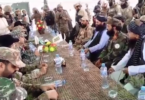KABUK (Pajhwok): The National Museum of Afghanistan has documented a total of 51,742 artifacts, including 1,361 objects seized from smugglers.
The series of registration of the artifacts is yet to be completed.
The National Museum was established in 1918 in the Baghi Bala area of Kabul before being shifted to the Koti Baghcha building at the Presidential Palace in 1924. Later on, it was moved in 1930 to Darul Aman locality, where it remains so far.
Yahya Mohibzada, the museum’s archive head, told Pajhwok Afghan News the institution had more than 100,000 different artifacts prior to the devastating civil conflict of the 1970s,
However, 70 percent of them were pillaged or went missing during the war, the official said. Its database was established in 2001 and 51,742 antiques have since been registered.
Of the registered items, 10,585 had been looted during wars and then recovered with the help of International Police (Interpol) and some other countries. They were handed over to the museum after recovery.
Over 10,000 historical artifacts were brought back from the US, England, Belgium, Norway, Switzerland, Japan, Iran, Pakistan, Malaysia and other countries.
Without going into details, Mohibzada said some of the historic artifacts of Afghanistan still exist in a number of foreign countries.
Over the past two years, he revealed the government had foiled bids to smuggle 1,361 antiques out of the country. The items recovered from smugglers were handed over to the museum and registered. Most of them are ancient coins and statues.
Such museum pieces date back to different periods — Islamic civilisation, before Christ, Kushan dynasty, weapons of the 19th century.
They also include items recovered from areas around the Mis Ainak’ copper mine in central Logar province.
He explained the National Museum had not suffered any harm during the political change of August 15 2021. All catalogued objects were safe, he maintained.
He insisted all ancient relics of the museum were physically secure and some of them stashed away in warehouses.
Every month, the National Museum welcomes about a hundred foreigners in addition to domestic visitors.
Following the political change in the country, attempts had been redoubled to secure historical relics, Mohibzada said.
However officials have repaired many relics over the past two years. Some cultural outfits had promised cooperation, but none has taken practical steps in this regard so far.
He added the incumbent interim administration government was relying only on its domestic resources in this regard.
Museums in Herat, Kandahar, Nangarhar, Ghazni and Balkh provinces are currently functional, with the government making efforts to bring the remaining rare pieces abroad back to the country.
Visitors also asked the caretaker government to focus on the development of cultural sites and museums across the country.
Mohammadullah, one of the visitors, remarked museums reflected the cultural and historic identity of a nation. Museums should be established in all provinces of the country, he suggested.
Idrees, another visitor, held a similar view. He urged IEA to pay more attention to preserving cultural assets of the country.







